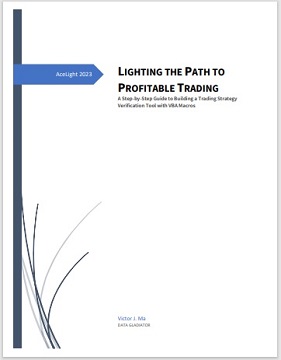From Rollercoaster Rides to Smooth Sailing:
Mastering Stock Market Analysis Strategies
|
|
Have you ever looked at a stock chart and thought to yourself, "This looks
like a rollercoaster ride I'm not ready to take?" Well, you're not alone.
The stock market can be a daunting place, full of ups and downs that can
make even the bravest investors feel queasy. But fear not, my friends! With
the right stock market analysis strategies, you can turn that rollercoaster
ride into a smooth sail on the open seas. Okay, maybe not that smooth, but
you get the point. So grab your life vest and let's dive in!
What is
the best strategies for analyzing the stock market? The truth is, there is
no one-size-fits-all approach to stock market analysis. Different strategies
work for different investors, and the key is finding the strategy that works
best for you. That being said, there are some common strategies that
many investors use to analyze the stock market. In this blog post, I'll
discuss some of the most popular stock market analysis strategies and
provide examples of how they work.
Fundamental Analysis
Fundamental analysis is the process of analyzing a company's financial
statements, industry trends, and other factors to determine the true value
of its stock. This approach is based on the belief that the stock market can
be irrational in the short term, but will eventually reflect a company's
true value over the long term.
There are many metrics used in
fundamental analysis, including earnings per share (EPS), price-to-earnings
(P/E) ratio, price-to-sales (P/S) ratio, and more. Investors may also look
at a company's debt-to-equity ratio, dividend yield, and other financial
ratios to determine whether the company is undervalued or overvalued.
One of the most famous investors to use fundamental analysis is Warren
Buffett, who has built his fortune by investing in undervalued companies
with strong fundamentals. For example, in the late 1990s, when tech stocks
were soaring, Buffett famously avoided the hype and invested in Coca-Cola, a
company with a strong brand and consistent earnings growth.
Technical
Analysis
Technical analysis is the process of analyzing stock charts
and market data to identify patterns and trends. This approach is based on
the belief that the stock market is a reflection of human behavior, and that
patterns in the market can be used to predict future movements.
Technical analysts use a variety of tools to analyze stock charts, including
moving averages, trend lines, and momentum indicators. They may also look at
trading volume and other market data to identify trends.
One famous
technical analyst is John Bollinger, who created the Bollinger Bands
indicator in the 1980s. This indicator uses a moving average and standard
deviation to identify trading bands around a stock's price. When the stock
price moves outside of these bands, it may signal a potential trend
reversal.
Value Investing
Value investing is a long-term
investment strategy based on the principle of buying stocks that are
undervalued by the market. Value investors believe that the market can be
irrational in the short term, but that the true value of a company will
eventually be reflected in its stock price.
Value investors look for
stocks with low P/E ratios, high dividend yields, and other metrics that
indicate a company is undervalued. They may also look for companies with
strong brand recognition, consistent earnings growth, and a history of
shareholder-friendly management.
One famous value investor is
Benjamin Graham, who mentored Warren Buffett and is often referred to as the
"father of value investing." Graham's approach involved analyzing a
company's financial statements in great detail and looking for stocks
trading at a significant discount to their intrinsic value.
Growth
Investing
Growth investing is a long-term investment strategy based
on the principle of investing in companies that are expected to grow faster
than the overall market. Growth investors believe that these companies will
eventually become leaders in their industries and that their stock prices
will reflect this growth.
Growth investors look for companies with
high earnings growth rates, strong competitive positions, and a history of
successful innovation. They may also look for companies with strong
management teams and a history of successful mergers and acquisitions.
One famous growth investor is Peter Lynch, who managed the Fidelity
Magellan Fund from 1977 to 1990. Lynch's approach involved investing in
companies that he understood and that had strong growth potential. For
example, Lynch famously invested in companies like Dunkin' Donuts, which he
discovered while drinking coffee at a local franchise. He believed that the
company had a strong brand and a loyal customer base, which would help it
grow over the long term.
Contrarian Investing
Contrarian
investing is a strategy based on the principle of investing against the
crowd. Contrarian investors believe that the market can be irrational in the
short term and that the best time to buy a stock is when it is out of favor
with the general public.
Contrarian investors may look for stocks
that have experienced a significant decline in price due to negative news or
market conditions. They believe that these stocks are oversold and may
present a buying opportunity.
One famous contrarian investor is Sir
John Templeton, who famously said, "The time of maximum pessimism is the
best time to buy, and the time of maximum optimism is the best time to
sell." Templeton made his fortune by investing in stocks that were out of
favor with the market, including Japanese stocks in the 1960s and 1970s and
emerging markets in the 1980s.
Quantitative Investing
Quantitative investing is a strategy based on the use of mathematical models
and data analysis to make investment decisions. This approach is popular
with hedge funds and other institutional investors, who have access to large
amounts of data and advanced analytical tools.
Quantitative investors
may use machine learning algorithms, statistical models, and other
techniques to identify patterns and trends in the market. They may also use
data from social media and other sources to gauge investor sentiment and
predict market movements.
One famous quantitative investor is James
Simons, who founded Renaissance Technologies in 1982. Renaissance
Technologies uses complex algorithms and data analysis to make investment
decisions and has generated some of the highest returns in the industry.
 And
there you have it, folks! A crash course in stock market analysis strategies
that will have you feeling like a pro in no time. Just remember, the stock
market is a wild and unpredictable beast, so always keep your wits about
you. just follow the advice of that old investing sage, Warren Buffett: "Be
fearful when others are greedy and greedy when others are fearful.” Happy
investing, and may the market be ever in your favor! And
there you have it, folks! A crash course in stock market analysis strategies
that will have you feeling like a pro in no time. Just remember, the stock
market is a wild and unpredictable beast, so always keep your wits about
you. just follow the advice of that old investing sage, Warren Buffett: "Be
fearful when others are greedy and greedy when others are fearful.” Happy
investing, and may the market be ever in your favor!
Last but not least, regardless of how famous and successful a stock
marketanalysis strategy may be,
even if it has been used by thousands of other people, before using it in
the real stock market, it's important to patiently conduct both back-testing
and forward-testing. This can help ensure that the strategy is sound and can
perform well under different market conditions. For more details, click on
LIGHTING THE PATH TO PROFITABLE TRADING: A Step-by-Step Guide to Building a Trading Strategy Verification Tool with VBA Macros to get the whole tutorial handbook for free!
And click Free Trial to download strategies testing tools, all for a 30-day Free Trial.
Click on Subscription to order more strategies testing tools to help your stock trading.
|


|

Free Tutorial
Share
|
|
|
|